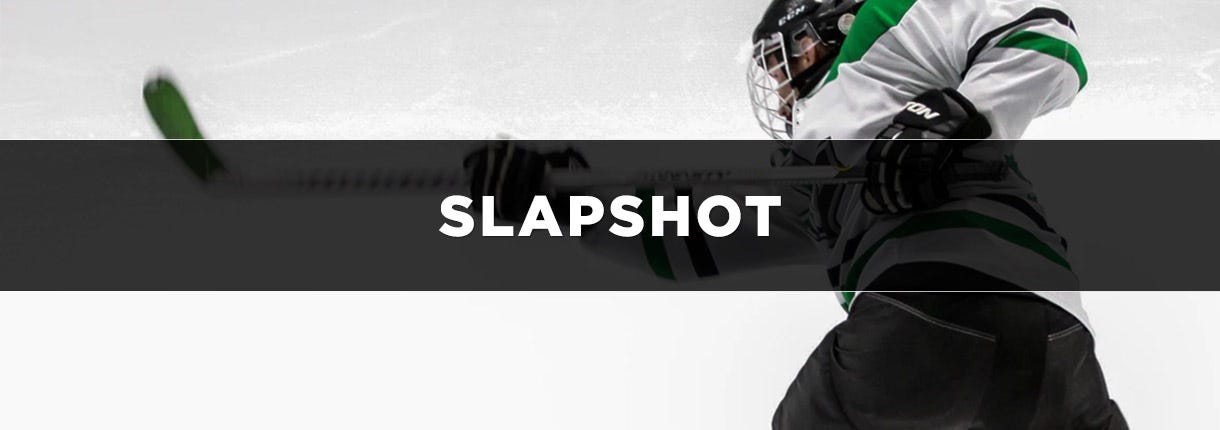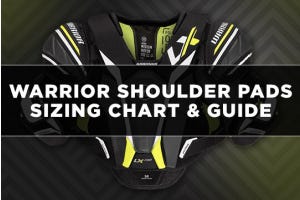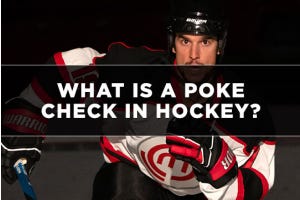Slapshot: A Guide to Hockey’s Famous Slapshot

Since the creation of Ice Hockey, the slapshot (also spelled slap shot) has been an integral part of the game. While it is a tricky skill to master, slapshots can be utilized by players of any position, helping them fire pucks on net with great power! That said, slapshots are more than simply just launching the puck as hard as possible at the opposing net. You will want to perfect the mechanics of a slapshot so you can generate power, as well as accuracy and control. This article will briefly explain how to shoot a slapshot, a brief history, along with some discussion about infamous slapshots from players in the NHL.
- What is a Slapshot in Hockey?
- How to Shoot a Slapshot
- The Average Slapshot Speed in the NHL
- The Fastest Slapshot in the NHL
- The All-Time Hardest Slapshots in Hockey
- Slapshot vs. Snap Shot vs. Wrist Shot
What is a Slapshot in Hockey?
A Slapshot in Ice Hockey is the hardest type of shot that a player can take. Usually utilized by defensemen, or bigger wingers, Slapshots are the best option for high-powered shots. Due to a big wind-up to generate the power, Slapshots generally require the most room and time compared to other shot types, which will be discussed later in the article.
How to Shoot a Slapshot
Below, you can find a step by step process on how to take a Slap Shot in Ice Hockey. Additionally, tips will be included to help perfect this shot type.
1. Wind the stick up to shoulder height
First things first, on a Slapshot, you will want to wind the hockey stick up to shoulder height or higher. Your bottom should be right around the mid-point of the stick. As the puck arrives, do your best to line it up a few inches behind your back foot, and one to two feet in front of you. Lining the puck up in this position will allow the stick to flex easier when it makes contact with the ice and puck.
2. Drive the shaft of the stick down and forward
Following the wind-up, comes the contact with the puck. As you make contact with the puck, drive the shaft of the stick down and forward, so all of the stored energy from your body weight is transferred from you, to the stick, and then ultimately to the puck. Really use the flex of the stick to your advantage for this type of shot.
3. Roll your wrists and transfer your body weight
Immediately after striking the puck, roll your wrists and transfer your body weight from your back leg to your front leg. This will help release the energy that is stored in the stick to the puck. Concluding the shot, it is important to fully follow through, with the blade of the stick pointed in the direction you want the puck to go.
Tips
As mentioned briefly before, it is important to lead with your bottom hand. Using all of your strength, you will want to push down and forward with this hand. Use the flex of your stick and really lean into the shot, leading with that bottom hand. Furthermore, it is important to rotate your hips as you follow through into the shot. As you start your initial wind-up you will be facing the puck, but as you start your “swing”, start rotating your hips and shoulders and follow through, so that when you are finished with your shot, you are facing the direction you want the puck to go. Doing this will help generate more power.
The second tip is to practice and experiment. Anyone can take a Slapshot, but the hardest aspect is learning how to perfect it. Starting out, it is recommended to get the fundamentals of the shot down, rather than going for all-out power. Work on your form and accuracy first, and the power will follow suit from there. Also, try experimenting with different sticks to see which works best for you. With many different stick options to choose from in terms of length, flex, and lie, you might find that a specific one might work better for slapshots.
The Average Slapshot Speed in the NHL
Over the years, technology in Ice Hockey sticks has progressed immensely, allowing players to shoot harder, while also being much lighter compared to Ice Hockey sticks in previous years. The average speed of Slap Shots in the NHL today is right around 100 miles per hour, compared to 10 seasons ago where the average was around the low 90’s!
The Fastest Slapshot in the NHL
Boston Bruins Defenseman Zdeno Chara holds the current fastest shot record in the NHL, blasting one 108.8 miles per hour in the 2012 All-Star Skills Competition! Standing at 6’9”, it is no surprise that Chara has the hardest shot in the league. He has used his build and strength to perfect the Slapshot over his career, which has commanded a lot of respect from opposing players and goaltenders league-wide.
The All-Time Hardest Slapshots in Hockey
Zdeno Chara: 108.8 mph
The hardest Slapshot ever officially recorded was shot by Zdeno Chara during the 2012 NHL All-Star Competition. Chara fired a shot of 108.8 miles per hour, which remains the fastest official shot.
Shea Weber: 108.5 mph
Closely behind Chara’s record of 108.8 miles per hour was a Slapshot from the then Nashville-defenseman Shea Weber. Weber fired off a shot of 108.5 miles per hour during the 2015 NHL All-Star Skills Competition.
Al Iafrate: 105.2 mph
The third hardest shot ever officially recorded was by Capitals defenseman Al Iafrate at the 1993 All-Star Skills Competition. Iafrate ripped the puck into the net at an incredible 105.2 miles per hour. This record stood from 1993 until 2009, when it was then broken by Zdeno Chara.
Slapshot vs. Snap Shot vs. Wrist Shot
The Snap Shot is the fastest type of shot you can get off your blade in the game of Ice Hockey. The idea behind it a snap shot is to get it off the blade as quickly as possible, making them a great option if you are right in the slot. Generally, on snap shots, your skates and chest are facing towards the net, meaning that most of the power behind the shot will come by leaning into the stick and using your body weight to push the stick down and out. While this shot type has the quickest release due to the lowest load times, and is fairly accurate, they are typically the “weakest” shot in terms of power.
On the contrary, Slapshots are great for players who want maximum power on their shots. With time and space, these shots are typically utilized by defensemen at the blue line and are a great option for getting the puck on net with full power. With that said, there are a few downsides that come with taking a Slapshot. For one, they take more time to perform. An opposing player has more time to come and steal the puck as the windup takes longer on this shot. Due to less immediate pressure (from the opposing Wingers), this is why we see a majority of slapshots taken by defensemen. The slapshot is also a little bit less accurate compared to something like a controlled Wrist Shot. This is due to the extended windup that comes with producing the power of a slapshot.
As you might have guessed, the Wrist Shot is a combination of the two, in a way. This shot is controlled and accurate, yet still quick to get off your stick blade. Unlike the Snapshot, your shoulder is facing the net, but your skates and chest are facing sideways (towards the boards). The power behind the shot is generated by arm strength and transfer of body weight. Bring the puck behind you for your “wind up” and as you start your shot, bringing it forward (towards the net), start transferring your body weight from your back leg to your front leg. From there, just as the puck is about to leave the blade, really roll your wrists (almost a flicking motion), and follow through with the blade of the stick pointed towards the net. The key here is to really lean into the shot with your lower hand and utilize the flex of your stick. Doing so will apply energy and weight into the stick, creating a whip-like effect, therefore more power behind the shot.
Who Invented the Slapshot?
The invention of the Slapshot is credited to a man named Alex Shibicky in the 1930’s, with the first one officially being used in a game during the 1937 season.
The Slapshot was then later popularized by a man named Bernard Geoffrion who, ironically, went by the nickname “Boom Boom” because of his infamous Slapshots. The Slapshot really “took off” in the 1950’s when Geoffrion and his teammate Maurice “Rocket” Richard were the first two teammates in NHL history to score 50+ goals in a single season. Since then, the Slapshot has been tweaked and modernized to cater towards the speed of today’s game.









Login and Registration Form
or
Create an account